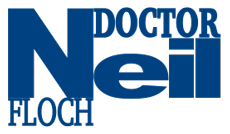THE PROCEDURE
Dr. Neil Floch has published several papers and book chapters on the Paraesophageal Hernia Repair. He is one of the country’s leading experts in performing this procedure. A paraesophageal hernia is a protrusion of the stomach through the diaphragm into the chest cavity. This surgery is performed to correct the defect in the diaphragm that allows it to occur. When the stomach herniates (bulges) upward into the chest it may move around or even twist on itself. Paraesophageal hernias occur when the stomach moves up along the side of the swallowing tube or esophagus. They are generally larger than sliding hiatal hernias, which are a direct upward protrusion into the chest.
Normally, the esophagus (food pipe) goes through a hiatus (small opening) in the diaphragm. The diaphragm is a muscular wall that separates the chest and abdomen (stomach). With PHR, the hiatus in the diaphragm is too large or the muscles around the hiatus are too weak. A sac can squeeze through this large opening and position itself next to the esophagus. This herniated sac may contain a part of the stomach. When this herniated sac gets trapped in the chest, it causes stomach acid to back up into the esophagus and damage the esophagus. The hernia may range from less than an inch of the stomach to one that includes all of the stomach and sometimes, other organs as well. The opening of the diaphragm may be very small or up to 4-5 inches in diameter. Patients with paraesophageal hernias will most likely suffer from heartburn, reflux, regurgitation or many of the other symptoms associated with GERD. In the most serious situations the stomach may develop ulcers, bleeding or twisting that could result in decreased blood flow and perforation of the stomach.
A paraesophageal hernia is commonly fixed with the laparoscopic technique involving 5 small incisions to make the enlarged opening smaller. Our surgeons use small incisions to enter the abdomen. The laparoscope, a thin telescope-like instrument, is connected to a tiny camera and then inserted through the small incision. This enables our surgeons to have a magnified image of the patient’s internal organs projected on high definition television screens in the operating room. This affords our surgeons the opportunity of having a better view of internal organs in greater detail than the traditional open procedure provides. The abdomen is inflated with gas, causing it to expand, and thereby allowing our surgeons to view the abdominal cavity and perform the procedure. During the surgery, the stomach is replaced back down into the abdomen. The opening in the diaphragm is made smaller and stitches or mesh material will be used to close or decrease the size. The procedure is combined with either a partial Toupet or a complete (NIssen) fundoplication.
BENEFITS OF THE PARAESOPHAGEAL HERNIA REPAIR
- Resolution of life threatening problems such as bleeding, perforation and pneumonia
- Resolution of heartburn and reflux
- Ability to stop antacid medications in 90% of patients
RISKS OF THE PARAESOPHAGEAL HERNIA REPAIR
- Recurrent hernia
- Vagotomy
- Recurrence of reflux
- Difficulty swallowing
- Gas bloating
- Problems may happen during the laparoscopic procedure that would necessitate converting the procedure to a laparotomy (open procedure).
- Blood clot
- Injury to nearby structures
- Bleeding and pneumothorax (collapsed lung)
BEFORE SURGERY
Please contact your insurance company to determine your benefits. If you require help, one of our patient advocates will assist you. Our surgeons will pre-screen you, and your condition will be thoroughly analyzed to make certain that you are an appropriate candidate for the procedure. Blood tests will be ordered as well as any other tests that our surgeons feel are necessary in evaluating your condition and eligibility.
DAY OF SURGERY
PRE-SURGERY – PHR is performed under general anesthesia and will require you not to eat or drink for several hours prior to the procedure. Your bowel might have to be emptied the night before surgery and our surgeons will advise you accordingly. The procedure itself will generally take 2 hours.
You will report to a pre-operative area where a nurse will review your chart and make certain that all of the necessary paper work is correct and present. Dr. Floch will meet with you, discuss the process, and answer any questions you may have. The anesthesiologist will conduct a pre-operative interview including questions concerning your medical history. Once everything has been confirmed and you are ready to proceed, the anesthesiologist will begin the IV. Then it’s off to the operating room where the anesthesia is administered and the operation is performed. PHR is performed under general anesthesia so you will be asleep for the entire procedure.
POST SURGERY – After the surgery is completed, you will be taken to a recovery unit where your recovery will be monitored by the nursing staff. You can anticipate spending one night to three nights in the hospital. However, this will depend on your condition and our surgeon’s evaluation. No one is sent home unless our surgeon is completely comfortable making the decision to do so. If it is determined that there is a need to keep you for an additional day, or days, you will remain in the hospital. You must provide for someone to drive you home when you are discharged. Generally the PHR requires a one-night stay.
Pain sometimes has a tendency to appear at the incision sight and our surgeon will prescribe medication for it in the event you are faced with this issue.
AT HOME
WHAT CAN I EXPECT?
- You will be on a pureed diet for one week
- Your diet will be advanced slowly to a regular diet in 2 to 6 weeks.
- You may return to activity in 1 to 2 weeks
- Prevent swallowing excess air by not using straws. Do not chew gum or tobacco. Avoid foods that cause gas
WHEN SHOULD I CALL THE DOCTOR
- Difficulty swallowing
- Experiencing the feeling that food is getting stuck
- Having pain when swallowing
- Bloating
- Nausea and vomiting
- Pain medication does not control the pain
- Redness or warmth continue to increase around the incisions
- Excessive swelling on bleeding from the incisions
- Temperature exceeding 100.5o for at least 4 hours.





